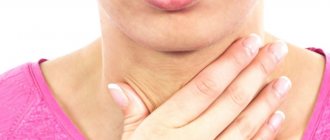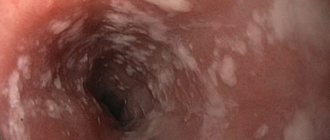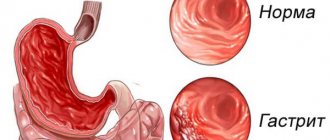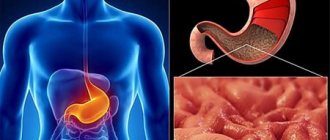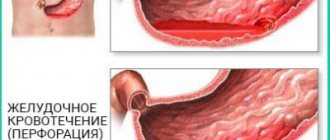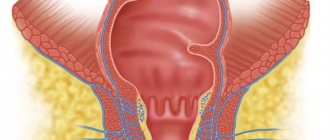Can it develop into cancer?
Esophageal erosion is a disease without a clear clinical picture.
Often the patient learns about his illness by chance during gastroenteroscopy. Minor symptoms on the part of the patient are accepted as a consequence of a violation of the diet, and that is why in most cases a doctor is consulted in the later stages of the pathology, when severe, sometimes even irreversible changes in the mucous membrane of the esophagus are recorded. Erosion is a superficial defect in the mucous membrane of the esophageal tube, which does not extend to the deeper layers of the esophageal wall. Foci of erosion can be single or multiple, varying in location and size. The consequences of erosion pose a serious danger.
Erosion can eventually turn into a deeper defect - an ulcer. There is a risk of infection with the development of esophagitis or heavy bleeding. When the disease is advanced, the erosive defect may undergo cellular transformation, which is a precancerous condition; the patient is diagnosed with leukoplakia or Barrett's esophagus.
In some cases, the changes are quite profound (esophageal cancer), and it is not possible to correct the condition even with surgery.
Diagnostic methods
Diagnosis of erosion of the esophageal mucosa begins with a conversation with a gastroenterologist, during which he will find out what the symptoms are, when exactly they appear, and what their frequency is. Also, the attending physician will definitely ask the patient about his other diseases in order to get a complete picture of the state of the body.
Further diagnostics usually include methods such as:
- x-ray,
- endoscopy,
- colonoscopy,
- laboratory tests of blood, urine, feces.
Goals and methods of conservative treatment
Drug treatment of reflux inflammation of the esophagus is aimed at eliminating the cause of the disease, reducing the severity of external manifestations, and recovery of the patient.
To successfully treat GERD with medications, you must:
- increase the obturator ability of the cardiac sphincter;
- eliminate motor disorders of the esophagus and stomach;
- normalize the acidity of gastric juice;
- restore the balance between protective mechanisms and aggressive factors of the esophageal mucosa.
Medicines for GERD are divided into several main groups:
- enveloping agents;
- antacid drugs;
- proton pump inhibitors (pumps) or PPIs for short;
- histamine receptor blockers;
- prokinetics;
- antibiotics;
- enzymes;
- healing agents.
Combinations of drugs are selected in accordance with the underlying disease that caused gastroesophageal reflux.
Causes of esophageal erosion
Erosion occurs for the following reasons:
- The entry of gastric juice into the esophagus, which greatly irritates the mucous membrane of this organ.
- There is a complication of a hernia that has appeared in the diaphragm.
- Burns and injuries to the esophagus occurred.
The disease can be detected only when examined by a gastroenterologist and during gastroscopic diagnostics.
The sooner this is done, the sooner treatment will begin.
Erosion provokes the development of many diseases, in particular:
- peritonitis;
- tumors of a malignant and benign nature;
- vascular thrombosis;
- stomach ulcer;
- bleeding of varying intensity;
- deformation of the mucosa, which provokes obstruction.
What it looks like, photo
When visualizing esophageal erosion, it is possible to record the severity and phase of the disease and determine the specific type.
The picture is as follows: the mucous membrane is inflamed, hyperemia and irritation are observed, you can clearly see foci of erosion, which in places are fused. In later stages, penetration of erosive lesions into the deeper layers of the mucosa and the formation of ulcers are observed. On the surface of the esophagus you can see scars after erosive lesions and ulcers, which cause narrowing of the lumen of the esophagus, its deformation and difficulty in swallowing.
Candidiasis of the esophagus
Candidiasis is an infectious disease that affects the mucous membranes. However, esophageal candidiasis is considered a visceral disease. Most often, esophageal candidiasis develops as a consequence of a burn of the esophagus, as well as in certain chronic diseases of this organ. With candidiasis of the esophagus, a person feels pain when swallowing , as a result of which it is quite difficult for him to do this. During swallowing, discomfort is felt behind the sternum. Most often, esophageal candidiasis is diagnosed in people with impaired functioning of the immune system ; in some cases, this disease can result from taking a large number of antibiotics . In addition, the causes of candidiasis are too much physical and emotional stress without proper rest, stressful situations, irregular and unhealthy diet. However, esophageal candidiasis most often occurs in HIV-positive .
To treat this type of candidiasis, a number of antifungal drugs are used, which are taken both intravenously and orally. In order to effectively treat this disease, it is important to entrust a specialist with the selection of drugs for therapy.
Enveloping agents
The esophageal mucosa experiences constant irritation and inflammation. The depth of damage to the walls of the esophageal canal depends on the degree of aggressiveness of gastric and intestinal enzymes. Alginates and antacids can protect the esophageal mucosa. Alginates contain a gel-like substance that creates a barrier to the penetration of hydrochloric acid into the esophagus.
Biogel Laminal is made from processed seaweed and contains alginic acid, iodine, selenium, zinc. Removes toxins, accelerates the healing of mucous membranes, relieves pain, and enriches the diet with minerals. Used for GERD for children from 6 years of age, a tablespoon 2 times a day 30 minutes before meals. Adults are recommended two tablespoons. The course of treatment is 2 weeks.
Traditional medicine methods
Knows how to treat esophageal erosion and traditional medicine. There are many effective and at the same time quite simple and accessible recipes. Here are some of them.
- Extract the juice from raw potatoes and take 50 ml four times a day for two months. Then take a break and start a new course.
- Make juice from raw carrots and drink 70 grams of it twice a day. Can be mixed with potato.
- In the morning on an empty stomach, take two teaspoons of honey, which remarkably restores the mucous membrane.
- 20 minutes before breakfast and dinner, drink 10-12 milliliters of sea buckthorn oil. The duration of the course is six to eight weeks. Sea buckthorn is considered one of the most useful plants in the treatment of esophageal erosion.
- Mix dry and crushed dill, chamomile, linden blossom, fennel, St. John's wort, valerian root, marigold and immortelle. Take a tablespoon of this mixture and pour 200 grams of boiling water over it. Take fifty milliliters three times a day.
Treatment of esophageal erosion with folk remedies should in no case replace or compensate for traditional methods. It should be carried out only in combination with taking medications prescribed by a doctor - and only after agreement with the latter.
Classification of the disease
Erosion is distinguished based on changes in tissue structures. Non-malignant erosions and lesions associated with neoplasms are distinguished. The course of the pathology can be acute or chronic.
According to the causes of occurrence, they are distinguished:
- Primary. Identified as an independent disease of the esophagus;
- Secondary. They arise as concomitant disorders of various gastrointestinal diseases.
The following types of erosion are also distinguished:
- Polypoid;
- Linear;
- Superficial;
- Multiple;
- Flat shape.
Linear erosion, which is often recorded in patients, has been especially studied. With a linear type of erosion, the upper layer of the mucous membrane of the esophageal tube is damaged. The damage can later transform into ulcerative formations. As the disease progresses, the ulcers merge into large lesions.
A linear type of erosion appears as a result of the development of a superficial form, when the disease is neglected.
Linear erosion is easily detected because the extent of the damage is large. This type leads to serious changes in the mucous membrane of the esophagus. Foci of inflammation after healing leave scars, which cause deformation of the esophageal tube. Deformations lead to narrowing and loss of elasticity, making swallowing and digestion difficult.
Symptoms
Depending on the course of the disease, the clinical picture looks different. Main signs of ulcers:
- Discomfort, pain. They occur in the left hypochondrium or in front of the peritoneum, at night. In the acute form, they occur in the form of attacks.
- Dyspeptic manifestations. Nausea, vomiting, heartburn, belching, and bowel dysfunction are often observed.
- Hemorrhagic syndrome. The presence of specific thick matter in feces and vomit. The feces have an uncharacteristic dark tint.
- Iron-deficiency anemia. Observed in chronic erosion. Accompanied by hair loss, brittle nails, and back pain.
- Asthenia. Main signs: weakness, fatigue, severe irritability, decreased performance.
It is important to know! Prolonged course of the disease and lack of effective treatment leads to a sharp deterioration of the condition. The clinic is supplemented with new symptoms. This is often associated with the occurrence of complications due to erosion.
The diagnosis is made by a doctor after a comprehensive examination
Antacids
Antiacid drugs for esophagitis neutralize hydrochloric acid in the stomach by reacting with it. Gels, suspensions, and chewable tablets contain aluminum, magnesium, and calcium salts. New generation products precipitate HCI to insoluble salts, which are excreted unchanged from the body. The most effective preparations combine aluminum and magnesium.
These include:
- Maalox;
- Gaviscon;
- Almagel;
- Rutacid;
- Gastal;
- Rennie.
Take symptomatically for heartburn attacks, without exceeding the indicated dosage. The effect of the drugs occurs within 5-10 minutes and lasts up to 3 hours.
Esophageal carcinoma
Symptoms and treatment of esophageal cancer are information that patients who have been diagnosed with Barrett's esophagus or other pathologies of this organ should definitely study. Esophageal cancer is a fairly common form of malignancy. More often the disease manifests itself in older men. As a rule, a malignant tumor affects the middle and lower parts of the esophagus.
There are some factors that contribute to the development of this disease. In particular, esophageal cancer can be caused by an incorrect approach to nutrition, namely, frequent consumption of alcohol and too hot food. The disease most often develops in people suffering from vitamin deficiency (especially A and C). Also, the likelihood of esophageal cancer increases in case of alkali burns.
With the development of esophageal cancer, the patient notes a general deterioration in health: weakness, fatigue, inability to work for a long time, a noticeable decrease in appetite. As a result, a person’s weight decreases sharply, and the skin often turns pale. Regurgitation is common. Due to unpleasant manifestations, a person is forced to switch to liquid, pureed food. But in some cases, due to severe dysphagia, a person cannot even swallow saliva. The manifestation of burning and pain, a change in the timbre of the voice is also characteristic.
As complications of the disease, bleeding of the esophagus and tumor perforation may develop. With such manifestations, it is extremely important to immediately seek medical help.
Diagnosis of esophageal cancer is made using instrumental methods: x-rays, as well as biopsy using endoscopy. Sometimes other additional tests are prescribed.
When treating esophageal cancer, surgery, radiation therapy, and combined treatment are used, which combines radiation and surgery. During the operation, the esophagus is removed, and plastic surgery of the gastric or intestinal tube is performed. Chemotherapy is used to improve the outcome of surgery.
If the process is too advanced, the patient is given a gastrostomy : a special feeding tube is inserted into the stomach.
Reasons for appearance
Diaphragmatic hernia, organ trauma and burns are indicated as the main causes of esophageal erosion. Other causes of destruction and inflammation of the walls of the esophagus include:
- Inflammation of the gastrointestinal tract caused by viruses or other infections;
- Lack of vitamins and reduced immunity, against the background of which tissue structures are damaged;
- Violation of intestinal microflora;
- Injuries resulting from regular consumption of hot food;
- Burns caused by the entry of aggressive chemical elements into the esophagus;
- Violation of the functionality of the sphincters;
- Previous surgical interventions;
- Atrophy of the left lobe of the liver;
- Anorexia and lack of fat layer;
- Disorders of the structure of the thoracic spine (kyphosis);
- Long-term use of medications, especially dopamine blockers, powerful painkillers.
Since the main cause of esophageal erosion is a diaphragmatic hernia, it is necessary to consider the causes of this pathology. A hernia appears when, through a hole in the diaphragm, upward into the chest cavity, the lower zone of the esophagus with part of the stomach, and in some cases other abdominal organs, are displaced.
The causes of the pathology are:
- Congenital or acquired high elasticity of the tissues and ligaments of the esophageal tube;
- A congenital developmental anomaly, when the length of the esophagus is too short, and the stomach occupies an incorrect physiological position;
- Increased cavity pressure as a result of excessive physical activity or obesity, multiple pregnancies, age-related changes;
- Neoplasms;
- Weak muscle tone;
- An increase in the diaphragm opening as a result of the influence of various factors;
- Curved spine.
Esophageal erosion can also be caused by:
- Inflammation 12 – duodenum;
- Bile duct stenosis;
- Gallstone diseases that arose as a result of difficulty in the outflow of bile;
- Abuse of alcohol, smoking;
- Destabilizing state of the body.
Causes of pathology
Erosive damage to the inner layer of a tubular organ most often becomes a consequence of other diseases. It is extremely rare that this disease is independent, primary. The following main causes of esophageal erosion can be identified:
- hernia of the diaphragmatic opening of a tubular organ, which appears as a result of insufficient tone of the muscles of its walls, various types of neoplasms or inflammation of the esophagus, thinning of the fat layer under the diaphragm, stretching of the lower sphincter, curved shape of the chest;
- prolonged stress, mental disorders;
- renal failure;
- liver pathologies;
- diabetes.
Primary type erosion often appears as a result of:
- constant injury to the walls of the esophagus with spicy, sour, salty or rough foods;
- exposure to chemicals;
- complications after operations;
- long-term smoking, alcohol abuse;
- hereditary factors.
Proton pump inhibitors
Treatment of esophagitis is impossible to imagine without proton pump inhibitors. Antacids from this group of drugs disrupt the synthesis of hydrochloric acid at the ionic level, thereby reducing the acidity of the stomach. All proton acidity blockers are benzimedazole derivatives.
The main active ingredients are:
- Omeprazole - drugs Omez, Promez, Losek.
- Pantoprozol – trade names Pantap, Nolpaza, Ulsepan.
- Lansoprazole is commercially available under the name Lantarol.
- Rabeprazole - found in the drugs Beret, Razo, Pariet, Rabeprazole.
- Esomeprazole - considered the most effective PPI, is available in the pharmacy chain as Emanera, Nexium, Ezokar, Neo-Zext.
In-demand inhibitor drugs for the treatment of reflux esophagitis in adults act for 24 hours. Take once a day before breakfast or after meals. Therapy is continued for up to 2 months. Together with antibiotics, they can cure gastritis and stomach ulcers - the original causes of reflux.
How to eat properly with esophageal erosion caused by reflux esophagitis
Walking after meals is required, at least for 15 minutes.
In addition to mechanical sparing of the mucous membrane, in this case, everything that can contribute to an increase in the acidity of the stomach contents, as well as its overflow, is excluded.
The frequency of meals should be 4-6 times a day, and food portions should be small.
You should not go to bed earlier than 3 hours after your last meal.
Under no circumstances should you physically work (especially bending over) after eating. Tight clothing, belts and belts are excluded. You can't lift weights.
After eating, you must walk in the fresh air for at least 15 minutes, and you must not smoke.
Example menu for erosion associated with reflux esophagitis:
- For breakfast, oatmeal with low-fat cottage cheese, a sandwich of toasted bread with cheese, dried fruit compote;
- Second breakfast can be represented by a large glass of homemade yogurt with fruit jelly;
- For lunch, vegetable soup is served, to which (after cooking) veal meatballs are added. For the second course - mashed potatoes in water with a fish cutlet, warm green tea;
- The afternoon snack is represented by fruit mousse with compote. You can have some cookies with the compote. As an addition, you can eat a couple of apples baked with honey;
- For dinner it is better to have baked fish with rice. The gravy should not be spicy or sour;
- Before going to bed, you can drink kefir with dried bread.
Erosion of the esophagus, in the absence of irritating factors, heals quite well, since the esophagus has an excellent blood supply and is also (normally) not constantly exposed to acids and enzymes. If the cause of the disease is associated with gastritis or an oncological process, then proper nutrition helps to cope with the underlying disease and improves the overall prognosis.
The esophagus is not as often affected by diseases as, for example, the stomach or intestines. After all, food does not stay in it for a long time, which reduces the risk of damage to the walls. But a certain part of the pathologies still occurs in the tubular organ. Erosion of the esophagus is considered one of the most insidious and dangerous. Its manifestations are not always noticeable, and yet the lack of treatment can lead to dire consequences, for example, oncology. Read about the causes, symptoms, methods of combating the disease (both medicinal and traditional), as well as the diet that patients need to follow in this article.
Survey
For an accurate diagnosis, an instrumental study is necessary. In the presence of parallel pathologies, preventive examinations are recommended every six months.
To establish a diagnosis, the doctor interviews the patient and collects anamnesis. The specialist determines the presence of atypical pain in the chest, in the spine or upper abdomen, clarifies the nature of the pain, and evaluates the condition of the skin and chest.
Laboratory tests are prescribed:
- General and biochemical blood tests;
- Analysis of urine;
- Examination of stool to detect hidden traces of blood.
The diagnosis is made only on the basis of instrumental examination. Apply:
- X-ray of the abdominal cavity using a contrast agent (barium sulfate). The procedure allows you to study the contours of the organ, determine the degree of damage to the mucous membrane, the tone and normal functioning of the lower esophageal sphincter. An X-ray examination reveals the presence of a diaphragmatic hernia;
- Endoscopy. The examination is carried out using thin flexible or rigid optical tubes or video systems, which allows you to visualize the condition of the esophagus, its walls, and also take a biopsy if necessary;
- Esophagotonocymography. The study is carried out with a multichannel probe with rubber balloons or open catheters. Allows you to study the surface of the organ mucosa, determine the extent of the lesion, the presence of ulcers;
- Colonoscopy. Allows you to visually inspect the walls of the esophageal tube;
- Ultrasound, CT, MRI if necessary.
Diagnostics
Prescription of drug therapy occurs after a comprehensive examination. The first stage of diagnosis is a consultation with a gastroenterologist, which involves a description of the characteristic symptoms, visual examination, palpation of the esophageal tube, abdominal organs, and thoracic area from the outside. To make a diagnosis, it is necessary to donate blood, urine for the presence of internal inflammation, infections, viruses, and a stool test for occult blood.
The main method is instrumental examination of the esophagus:
- endoscopy;
- manometry;
- radiography;
- ultrasonography;
- pH-metry;
- colonoscopy;
- fibroesophagogastroduodenoscopy;
- biopsy;
- ECG.
Manometry allows you to identify violations of the motor and contractile functions of the esophagus, and the work of the lower sphincter. X-rays and ultrasound are additional diagnostic methods aimed at identifying damage and inflammatory processes in the abdominal and thoracic organs.
Inflammation of the mucous membrane can be caused by spontaneous entry of hydrochloric acid into the esophagus from the stomach due to the anatomical features of the sphincter, poor nutrition, and failure to follow the rules of eating. Therefore, if there is a constant burning sensation, pH testing is prescribed - measuring the acid-base balance of the body throughout the day.
The characteristic signs of esophageal erosion coincide with the main symptoms of inflammation of the duodenum, therefore, to exclude pathology, a colonoscopy is performed. Fibroesophagogastroduodenoscopy is prescribed for suspected esophagitis and gastrointestinal diseases. During the study, biological material is taken (biopsy) for possible detection of a cancerous tumor. Similar symptomatic manifestations are observed in pathologies of the cardiovascular system, so an ECG is a mandatory procedure.
Histamine receptor blockers
H-2 histamine blockers inhibit the action of histamine. Secretion of HCI occurs in the parietal cells of the gastric mucosa. Secretory cells are located mainly in the fundus. Histamine is a mediator in the reaction of synthesis and release of hydrochloric acid. The substances in histamine blockers are similar in structure to histamine. They bind to histamine-sensitive receptors, turning them off temporarily.
Medicines from the group of histamine blockers:
- Lafutidine;
- Cimetidine - analogues Belomet, Simesan, Gistodil, Primamet;
- Roxatidine – marketed as Roxane;
- Ranitidine - found in the drugs Acyloc, Gistak, Zantac, Ranisan;
- Famotidine - can be found under the names Gasterogen, Kvamatel, Ulfamid, Famotel.
Diet
Proper nutrition for esophageal erosion is an important factor for recovery. The diet involves excluding spicy, fried, and too hot foods from the diet. Dishes should be cooked boiled, baked, or steamed. Casseroles, jelly, and soufflé are good for the esophagus. You need to eat fractionally (up to 5 times a day), but in small portions. Authorized products include:
- vegetable or cereal broths;
- oatmeal, buckwheat or rice porridge;
- lean boiled meat in the form of steam cutlets, meatballs;
- baked fish;
- fruits and dried fruits in the form of compotes, jelly;
- scrambled eggs;
- dairy products (except for sour cottage cheese, sharp cheese, full-fat sour cream).
As for prohibited products, there are many of them. In case of erosive esophagitis, it is prohibited to consume:
- chocolate;
- coffee;
- strong teas;
- ice cream;
- fresh bread;
- baking;
- sour vegetables, fruits;
- marinades;
- spices.
When esophageal erosion is diagnosed, a therapeutic diet is prescribed. In most cases, nutritionists recommend treatment tables number 1a (in acute cases), number 1b (during remission) and number 1 (must be followed constantly).
- The patient's diet should consist of liquid and pureed vegetable soups, seasoned with sour cream or cream, and steamed fish or meat cutlets. Oatmeal or fruit jelly is useful; you need to choose only sweet varieties of fruits and berries.
- It is recommended to eat steamed omelet, mashed potatoes, pureed and slimy buckwheat porridge, rice, and oatmeal for breakfast. The menu should include pasta, low-fat dairy products, boiled or baked vegetables and fruits, dried fruit compotes, and soft pastries without crust.
- The consumption of hot, sour, spicy, fried foods, pickled and canned foods, coffee, cocoa, and strong tea is not allowed. The use of citrus fruits, chocolate, caramel, nuts, seeds, fatty meats, and strong broths is prohibited.
- Meals should be small but frequent, food should be chewed well. Food should be consumed warm (not hot). You need to prepare food by boiling and baking.
- You need to completely stop drinking carbonated and alcoholic drinks and smoking. In severe cases of the disease, fresh vegetables and fruits should be excluded from the diet.
Therapy
An effective way to quickly restore damaged epithelium of the internal walls is to treat erosion of the esophagus with drugs. In addition to medications, the patient is prescribed physical therapy, including electrophoresis, mud therapy, and balneotherapy.
The main means are:
- prokinetic drugs;
- antacids;
- antisecretory agents;
- preparations of enveloping, protective action;
- blockers – proton pump inhibitors;
- antispasmodics.
Prokinetic agents Domperidone and Motilium improve the process of digestion of food and accelerate the passage of food from the stomach to the intestines. Antacids Gastal, Almagel, Vikalin neutralize acid in the esophagus, thanks to the chemical elements included in the composition: magnesium, aluminum. Antisecretory agent (alginate) Gaviscon and enveloping medications Sucralfate, Keal protect the mucous membrane from the aggressive effects of concentrated gastric juice and bile.
Nutrition for erosion
When making a diagnosis, the doctor must prescribe a diet. In many clinical cases, poor nutrition provoked diseases of the gastrointestinal tract and the formation of deep damage to the mucous membrane. Failure to follow a diet during esophageal erosion leads to the development of complications, which are accompanied by dangerous symptoms: bleeding, vomiting mixed with bile. The diet should include healthy, varied foods.
Patients should and can eat:
- vegetable soups, broths;
- meat, fish dishes, steamed, baked in the oven;
- boiled, fresh vegetables;
- fermented milk products with low fat content;
- eggs;
- porridge;
- cereals, pasta;
- fruits, berries;
- fresh baked goods;
- compote, jelly, water.
A mandatory rule of the diet is split meals in small portions, not exceeding 200-300 g per meal, and thorough chewing. When eating food, you must monitor the temperature: very cold and hot foods are strictly prohibited. In acute forms of erosion, you can only eat heat-treated foods, vegetables, and fruits.
Treatment of erosion of the esophageal mucosa with folk remedies involves the use of simple ingredients, herbs, plants:
- juice of raw potatoes, carrots;
- honey;
- sea buckthorn oil for healing scar deformities;
- infusion of dill, chamomile, linden, fennel, St. John's wort, valerian;
- a decoction of fireweed, horsetail, celandine, caraway;
- flax seeds.
It is recommended to take fresh root vegetable juices before each meal for several weeks. Drinks reduce the inflammatory process and restore damaged mucous membranes. Sea buckthorn oil, which promotes the natural healing of scar deformities and the destruction of pathogenic bacteria, is consumed after meals during the course of treatment - at least 20-30 days.
Prokinetics
Prokinetic drugs and acid blockers play an important role in the treatment of esophagitis. The action of prokinetics is aimed at stimulating peristalsis of the antrum. The process of evacuation of stomach contents into the intestines is accelerated, congestion is eliminated, and the tone of the esophageal sphincters increases.
Indications for taking prokinetic medications include nausea after eating, heaviness in the stomach, flatulence, belching, and heartburn. All known trade names of prokinetics are based on the substance domperidone.
Pharmacy chains offer medications:
- Domet;
- Motilium;
- Domstal;
- Domridon;
- Motinorm;
- Passengers.
Causes
The disease is considered as a complication that develops when the acidic contents of the stomach flow back into the esophagus.
Factors that give rise to this condition:
- Genetic predisposition.
- Neurotic disorders.
- Increased intra-abdominal pressure during pregnancy, obesity and bloating.
- Prolonged stress.
- Weakness of the muscular layer of the esophagus.
- Problems with the functioning of the sphincters.
- Chemical and thermal burns.
- Tobacco smoking.
- Liver cirrhosis, diabetes, kidney disease.
- Neoplasms in the esophagus, inflammation of its walls and, as a result, a decrease in length.
- Abuse of carbonated drinks, coffee, citrus fruits, antispasmodics, narcotic painkillers, nitrates and other medications.
Erosion develops in weakened patients suffering from vitamin deficiency and a lack of certain minerals, which causes oxygen starvation of tissues. Defects in the mucous membrane can be caused by food that is too hot or chemically aggressive. But more often, ulcerations are formed due to insufficiency of the lower sphincter, leading to reflux.
Consequences
Esophageal erosion is a serious disease. Neglect is fraught with serious consequences and the occurrence of secondary pathologies. There is a possibility of developing:
- Bleeding. It is the most dangerous complication of esophageal erosion. Bleeding in an organ cavity occurs when a blood vessel in the organ wall is damaged. The pathological condition is revealed by vomiting mixed with scarlet blood. The condition is typical for young patients who abuse tobacco and regularly drink alcohol.
- Peptic ulcer disease. The disease can be acute or chronic with periodic relapses. This type of complication often develops in older people.
- Neoplasms. Erosion of the esophagus is often a prerequisite for the appearance of a tumor disease. There is a possibility of the formation of both benign and malignant tumors.
Esophageal erosions, if left untreated, develop into hyperplasia (increased cell growth). As a result, the cells begin to change internally, which leads to their degeneration into malignant tumors.
- Blood flow failure. As a result of erosive processes, thrombosis of the esophageal vessels, disruption of cell nutrition, and necrosis of tissue structures are possible.
- Disorders of the structure of the esophagus. Erosion of the esophageal tube often leads to the formation of connecting scars. Scars disrupt the normal structure of the esophagus, complicate the swallowing process, and cause problems with digestion of food.
Symptoms of the disease
A reliable sign of erosion is incessant heartburn , the cause of which is the predominance of sour, fried or spicy foods in the diet. A severe course of the disease is indicated by a burning sensation in the throat that is not associated with meals.
Common symptoms include pain in the sternum, reminiscent of angina pectoris. It bothers me after eating or while lying down. Associated with the aggressive effects of hydrochloric acid, injury to the mucous membrane, mainly in places where defects develop.
A person often does not pay attention to such signals and associates them with eating stale foods.
The consequence of passive flow of stomach contents is nausea in the morning, complaints of hiccups, and sour belching. Multiple erosions are accompanied by pain when swallowing dry and coarse foods, as well as hypersalivation.
Vomiting mixed with blood accompanies severe conditions. It occurs in those who are not treated or who abuse alcohol.
Antibiotics
Since the late 80s of the last century, antibiotics have taken a leading position in the treatment of gastritis, ulcers and their consequences in the form of erosive reflux esophagitis. They fight the cause of erosive lesions of the mucous membrane - Helicobacter pylori.
Elimination of bacterial infection is carried out by the combined effects of penicillins and macrolides. Acid-fast antibiotics for inflammation of the stomach and esophagus - amoxicillin and clarithromycin. Apply 2 times a day. The dosage is calculated individually, taking into account age, weight, and concomitant diseases.
Candidal fungal infection of the esophagus is treated with Nystatin, Ketoconazole, Fluconazole, Clotrimazole, Miconazole. Candidiasis occurs in weakened, elderly people suffering from autoimmune diseases.
Taking antimicrobial agents can lead to antibiotic-associated diarrhea. Abnormal stool occurs from the death of beneficial microflora in the intestine and its colonization by pathogenic microbes - clostridia. Prevent imbalance of the symbiotic flora by prophylactic use of probiotics. The most common probiotics are Linex, Eubicor, Acipol, Enterol, Bifiform. Pharmaceutical drugs are replaced by products with probiotics - acidophilus, bifilux, kefir, fermented baked milk, sauerkraut.
Causes
Ulcers can occur due to the following factors:
- bacterial infections;
- regular emotional stress, stress;
- consumption of low-quality products;
- taking nutritional supplements, hot and cold foods;
- long-term drug therapy (taking non-steroidal anti-inflammatory drugs, antibacterial agents);
- harmful working conditions;
- the presence of chronic diseases of the digestive tract and endocrine system;
- heredity.
Helpful information. In the presence of several negative factors, the risk of stomach damage increases. It is worth monitoring your health and nutrition.
Vomiting is the first sign of damage to the esophagus
Forecast
Therapy for esophageal erosion has a favorable prognosis, provided that treatment is organized in a timely manner and is aimed at eliminating irritating factors.
To prevent such a serious pathology as esophageal erosion, it is necessary to promptly treat gastrointestinal pathologies, lead a healthy lifestyle, give up unhealthy habits, eliminate toxic effects on the esophageal mucosa, and also prevent burns and injuries to the surface of the organ. Avoiding depression, stress and a positive attitude will help improve your health, boost your immunity, leaving no chance of the appearance of various diseases, including pathologies associated with digestion.
Esophageal achalasia
Esophageal achalasia is a neurogenic disorder in which the functions of the esophagus are impaired. In particular, peristalsis is impaired, and the lower esophageal sphincter, which serves as a locking mechanism between the stomach and esophagus, loses its ability to relax. The etiology of this disease is unknown, but today experts are talking about the presence of genetic, infectious and psychogenic disposition. As a rule, the disease develops in people aged 20 to 40 years.
When a patient develops esophageal achalasia, the symptoms of the disease are expressed by frequent regurgitation ( regurgitation ). In this case, food is thrown back into the oral cavity, saliva and mucus are mixed with it. Typically this happens when a person leans forward. In some cases, regurgitation leads to aspiration (undigested food enters the person's lungs). In addition, the patient periodically develops chest pain, which may resemble angina . At night, a person may experience coughing attacks. Patients with esophageal achalasia, as a rule, rapidly lose weight, even to the point of exhaustion.
The main method for diagnosing this disease is fluoroscopy, which allows one to assess the condition of the esophagus. In the early stages of the disease, a person feels much better if he follows a gentle diet . Treatment of the disease is aimed at reducing pressure in the lower esophageal sphincter. Initially, special devices are used that help to relax it. The so-called pneumocardiodilation method is widely used, in which pneumatic relaxation of the sphincter is performed. To reduce pressure in the sphincter area, nitrates or calcium antagonists can be used.
Reviews
Dear readers, your opinion is very important to us - therefore, we will be glad to receive feedback about esophageal erosion in the comments, this will also be useful to other users of the site.
Arkady
I'm a beer lover. I constantly drank the drink, sometimes combining it with coffee, a cigarette, or chips. As a result, inflammation of the esophagus appeared, which became a concern at a fairly late stage, when erosive foci formed on the mucous membrane. I had to undergo treatment for a long time, took enveloping agents, and followed a strict diet. I had to forget about junk food and tobacco forever.
I felt certain difficulties when swallowing. The condition was accompanied by belching and other unpleasant symptoms associated with the digestive process. I thought I had gastritis, so I turned to a specialist. The acidity was increased, but the cause of the pathological condition was inflammation of the esophagus. A hardware test confirmed the doctor’s proposal; it turned out that I had esophageal erosion.
Treatment with medications
Treatment of esophageal erosion cannot be accomplished without the use of medications.
Throughout the treatment you should be under the supervision of a specialist.
As a rule, the following groups of drugs are used for treatment:
- Alginates.
Their function is reduced to the formation of thick foam on the gastric mucosa, which can minimize the unwanted effects of acid penetrating into the esophagus. The most famous drug from this series is Gaviscon.
- Antacids
Able to envelop the mucous membrane and relieve pain. Almagel is a drug that is ready to cope with moderate symptoms.
The product is taken half an hour before meals and at night.
- Prokinetics
These drugs help food move through the digestive canal as quickly as possible. The most popular drugs in this category are Motilium and Domperidone.
You cannot prescribe any of these drugs yourself. First you need to consult a doctor.
Nutrition and lifestyle for reflux esophagitis
Treatment of inflammation of the esophagus with medications takes place against the background of a strict diet. Nutrition rules to follow:
- cooking methods - boiling, stewing in water, baking without oil;
- food temperature from 30 to 50°C;
- consistency of food - mashed potatoes, soufflés, pates, pureed soups, boiled porridges;
- meat – chicken, rabbit, turkey, beef;
- fish - cod, hake, pike perch, greenling, pink salmon;
- cereals – semolina, rice, oatmeal, buckwheat;
- vegetables - potatoes, pumpkin, zucchini, carrots;
- fruits - bananas, apples, pears;
- milk – boiled low-fat, low-fat kefir, cottage cheese;
- bread - without yeast, white, yesterday's bread, dried;
- cookies – dry, unpalatable, without additives;
- drinks - herbal tea, rosehip decoction, dried fruit compote, still mineral table water, jelly.
The mucous membrane of the esophagus and stomach is protected as much as possible from thermal, chemical, and mechanical damage. After eating, you should not bend over or lie down for an hour. You should sleep on a raised headboard.
Reflux esophagitis is treated by reducing acidity, eliminating inflammation, and regulating gastric motility. The drugs are combined to achieve optimal therapeutic effect. The effectiveness of medications is increased by diet and avoidance of harmful addictions. The immune system is strengthened by folk herbal remedies and adherence to work and rest regimes.
- How to treat a burn of the esophagus with gastric juice
- Treatment of colitis with medications - the most effective drugs
- Duodenogastric reflux - treatment of gastric dysplasia
- Drug treatment of gastric erosion
The principle of choosing nutrition depending on the depth of the problem
Fibrogastroscopy will help to identify how advanced the disease is.
It is impossible to determine the severity of the condition “by eye”, because People's pain thresholds differ significantly, which can mislead the patient and the doctor. The diet is prescribed only after examination by a gastroenterologist, who in such cases prescribes fibrogastroscopy, and can clearly see the severity of the inflammatory process and the depth of erosion.
If only the mucous membrane was damaged, then diet No. 1 is prescribed.
Those. the patient can eat soft cereals, purees, dairy, stewed vegetables, soups and compotes.
In case of second-degree burns or other severe injuries to the esophagus, treatment and method of nutrition are determined in the surgical hospital.
Feeding through a nasogastric tube is used in particularly difficult cases
As a rule, such patients are not fed for several days, but nutrients are administered intravenously. This is necessary to prevent injury and infection of the erosion. In especially severe cases, the patient is transferred from droppers to feeding through a nasal tube. Liquid food in this case enters, bypassing the esophagus, directly into the stomach. The frequency of feedings in this case is 6 times a day.
After some time, under the control of a fibrogastroscope, doctors come to a decision to transfer the patient to a dietary diet.
If burns or other causes of erosive phenomena are very deep, or if the patient physically cannot swallow (the reflex is impaired), surgical treatment is performed. This, as a rule, becomes clear during the first week from the onset of chemical, mechanical or thermal damage to the mucosa.
Meat soup with meatballs is an excellent first course option for esophageal erosion.
If erosion is not caused by reflux, then you can eat any soups with meat, fish, mushroom, vegetable or cereal broth. Extractive substances in this case do not harm, because the esophageal mucosa does not depend on the reflex release of hydrochloric acid by the lining cells of the stomach.
If the nature of the erosion is associated with GERD (reflux esophagitis), then the broths can only be vegetable or cereal.
The best cereals to eat are oatmeal and rice. These dishes have a good enveloping effect and protect the mucous membrane from damage by the rest of the menu. Boiled buckwheat porridge is also allowed.
Oatmeal perfectly envelops the mucous membrane, which is important for erosion
Pearl barley, wheat and millet porridges are contraindicated, because their rough structure damages the mucous membrane at the site of erosion.
Meat can, however, be well-boiled, lean, in the form of steamed cutlets, soufflés or meatballs in soup.
Semi-finished products for esophageal erosion are strictly contraindicated, because Remnants of hormones in cheap meat contribute to the exacerbation of the inflammatory process.
It is better to bake the fish or serve it in the form of steamed fish cutlets.
Eggs are preferable soft-boiled or in the form of a steam omelet in the absence of associated digestive problems.
Almost all dairy products are allowed, except sharp cheese and sour cottage cheese.
Vegetable oil should be used more than butter. It is better to take olive oil or good refined sunflower oil.
Vegetables contraindicated for esophageal erosion (photo)
Vegetables are served exclusively stewed or boiled. Tomatoes and tomato juice, cabbage, radishes and radishes are excluded.
Preference should be given to potatoes and dishes made from them. In this case, it is not only a valuable source of calories, but also an astringent and inflammation-reducing substrate.
To support basic therapy, you can drink half a glass of fresh potato juice 2 times a day throughout the day.
Fruits can be in the form of jelly or compotes. Mashed bananas and sweet apples are allowed. The rest is undesirable due to the high acidity of the pulp. Citrus fruits, sour apples, and melons are contraindicated. Pears are not indicated, since constipation can provoke reflux esophagitis.
Smoked meats, pickles and marinades are contraindicated due to their aggressive effect on the mucous membrane. The same applies to carbonated drinks, strong tea, coffee and cocoa.
Позитивные проверенные шлюхи Ставрополь, сочные и сладкие, они такие модельные и молоденькие, что тебе обязательно захочется секса. Это будет волшебно. Куколки - проверенные шлюхи Ставрополь с yesstavropol.ru встречаются с достойными и интересными мужчинам. Вам требуется только ознакомиться с перечнем анкет и довериться своему вкусу, оценив привлекательность проститутки для себя по фотографиям.


